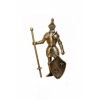|
 Antique weapons
are acquired to serve for various purposes, as a decorative element of the styled
interior, unique present to investments or for creation of major collection. Criteria
to collect antique weaponry depend on welfare and taste of a human being and it
is hard to say what exact kind of weaponry wins high esteem. Antique weapons
are acquired to serve for various purposes, as a decorative element of the styled
interior, unique present to investments or for creation of major collection. Criteria
to collect antique weaponry depend on welfare and taste of a human being and it
is hard to say what exact kind of weaponry wins high esteem.
The weapon
is far more reliable than any currency, in the opinion of the qualified
collectors since investments into weapons provide from 10 to 30% of annual
profit. Still, investments into weaponry are made by few well-to-do aesthetes
because the increasing market of antique weaponry is quite random.
One should not
be a billionaire to go in for collecting antique weaponry since the cost of
such a weapon comes from 300 dollars and the highest point is very far under
the skies, and everything depends on the kind of weapon which is assessed for
its exclusive characteristics.
Thus, a
dueling pair of guns of the late XIX century costs 3000 to 5000 dollars. An army
45-caliber Automatic Colt Pistol (series number 1 of 1873 issue) was recorded
into the Guinness Book of World Records for it was sold at Christie's Auction
in 1987 for USD 242 000.
In view of the above we see that the expert value is
either approved or disproved by the auction only.
If you consider
the time relation, then it is easier to acquire the samples of the second half
of the XIX and beginning of XX century. If you want to have a gun of XVIII century,
you have to take pains and pay a fortune though the cost of more ancient models
will come to dozens of thousand USD.
If you think
of armor that is recently in vogue to decorate ‘knight halls' in the houses of the
well-off, then the cost of them at the international auctions varies from 100000
dollars since they are in great demand, while the amount of really ancient
models remaining is few.
The cost of
the old-time sabre fluctuates from five to three hundred thousand dollars providing
that famous warriors and commanders did not touch the blade, and if it is documented
the cost of the sample will increase to incredible sizes.
Thus, in
2007 at the French auction Napoleon's saber of about one meter long and rich incrusted
in flowery patterns in eastern style, was
primarily assessed by experts for the amount of 1,6 million dollars and that
sword was sold for 6,5 million dollars at the auction.
This saber of
more than two hundred years belonged to the great commander long before he
became an Emperor. The weapon was sold to the foreign purchaser but since the sword
was the national property of France, and the new owner was put to liability to
bring it to the country once a year for at least six months.
Collectors
pay a thorough attention to the weaponry manufactured in the East that was
always richly incrusted with gems, gilding, engraving and carving. Such luxury
works of art cost far more expensive. Katana (Japanese sword), Tanto (Japanese fighting
knife) and Keris (steel dagger with snake-like blade) were finely ornamented
with precious stones and were often made from precious metals. By the way, an antique
steel sword of special hardening costs far more expensive in this case then all
the jewels and gems used for this ornament.
Very
popular model as examples of Hong Kong auctions at Sotheby's named as ‘Qianlong
- Sovereign, Warrior, Patron'. Ceremonial Chinese saber of the eighteenth century
with the handle made from carved nephrite was sold for USD 5 935 476 to the
Chinese businessman, though its start price was USD 1,5 million upon the expert
assessments. This is the highest price for cold arms from China throughout the
entire history of Sotheby's. In the epoch of the Emperor Tsyanlun (1736-1796 годы)
sabers similar to this weapon poetically named as ‘Flying Treasure' was made in
ninety items but it did not come to auctions for sale.
Just for information;
the cold weapon manufactured in the East is considered as better in many
aspects unlike the European. The Arab weapon, particularly famous among the collectors
Isfahan swords and Japanese cold weapon, won the popularity due to perfect
quality of style and finish. The works of art of European gunsmiths was perfected
mainly at single models of highly artistic and valuable weapon the cost of
which was too high to be afforded by few solvent persons.
In a word, collection
of the antique weaponry is an interesting and excitable occupation that reveals
passion of the holder to guns that can be available in any form, from head of Scythian
spears and Italian war hatchets ‘fashi' to armament of Japanese ninja and
signal canons. The permanent is only one thing - it allows the bearer to feel himself
a Man from capital letter and to please himself.
|